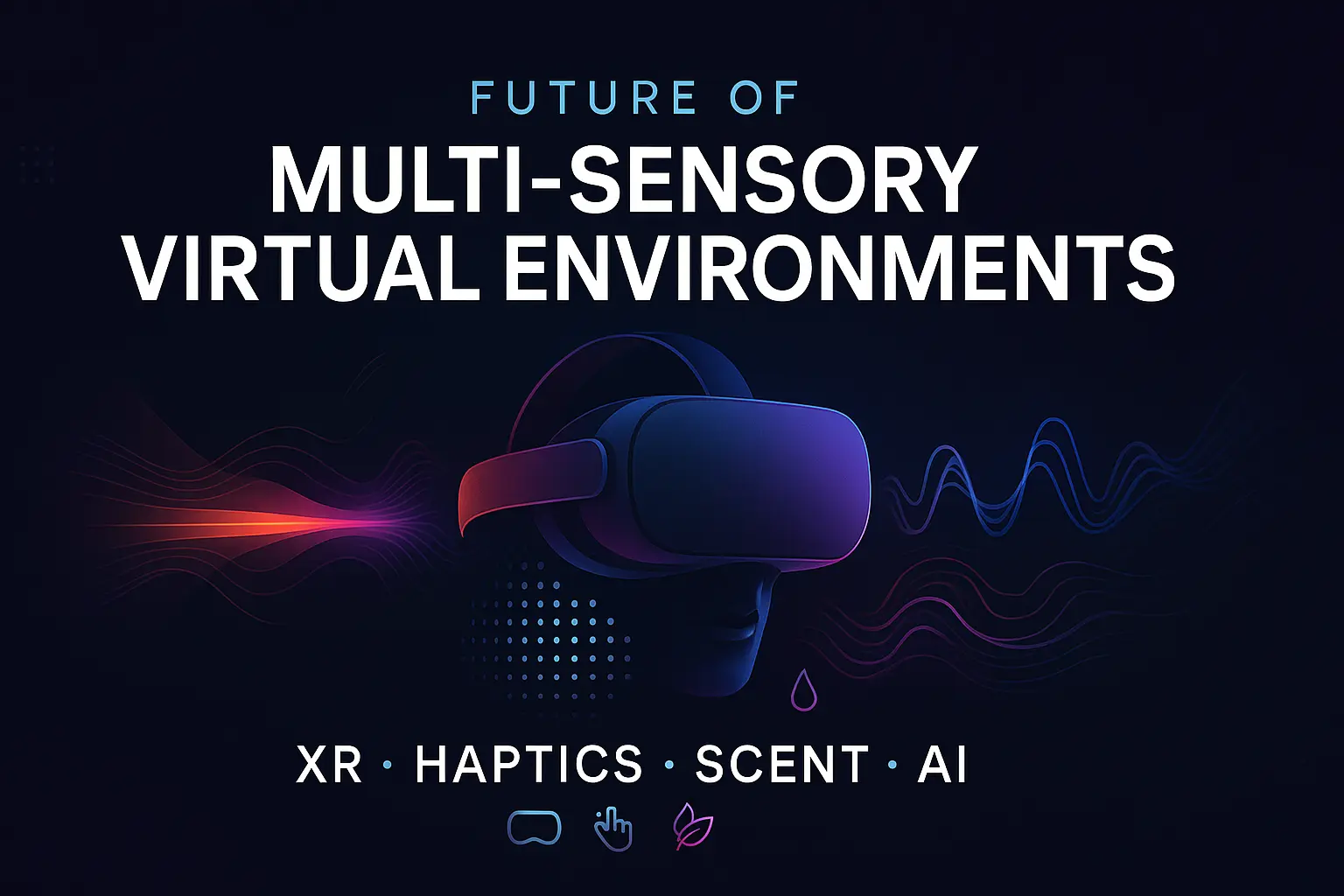Introduction
Virtual worlds are breaking out of the “see and hear” box. Multi-sensory virtual environments (MSVEs) blend sight and sound with touch, temperature, airflow, smell, and even limited taste to create experiences your brain treats as real. When cues are timed well, people learn faster, make better decisions, and feel more present—whether they’re training for a high-stakes task, shopping, or just exploring.
What Makes an Experience “Multi-Sensory”?
An MSVE engages more than two senses at once, and the cues line up. A windy cliff feels breezy on your skin, the roar of waves arrives from the right place, and the visuals match the motion. The magic isn’t about more gadgets; it’s about consistency and timing:
- Haptics: vibrations, pressure, and force feedback in gloves, vests, or fingertip pads
- Thermals & airflow: warm/cool pulses and wind bursts mapped to events
- Olfaction: small scent cartridges that release tiny, timed notes
- Spatial audio: realistic direction, occlusion, and reverberation
- Visual fidelity: wide FOV, eye-tracked rendering, and stable frame times
How the Tech Works (Quick Tour)
- Devices: headset + one or more wearables (gloves, sleeves, vest) + optional scent module + small fans/heaters
- Software: engines like Unity/Unreal drive scenes; OpenXR/WebXR keep hardware portable; device SDKs schedule cues with safety caps
- Sync layer: aligns audio, visuals, and haptics so the “thud” you see is the “thud” you feel
- Compute: local rendering plus edge/cloud bursts for heavy moments; tight latency budgets keep everything comfortable
- Adaptation: AI directors tune difficulty and intensity based on user performance and comfort
Where MSVEs Create Real Value
Healthcare & Therapy
- Surgical rehearsal with force feedback on instruments and tissue layers
- Exposure therapy with carefully controlled soundscapes and scents
- Physical rehab games that reward fine-motor improvements via tactile cues
Industrial Training & Safety
- Lockout/tagout drills with realistic tool feel
- Fire and confined-space simulations with heat and airflow warnings
- Hazard recognition where subtle haptics “nudge” attention to risks
Retail & Ecommerce
- Fabric, footwear, or steering-wheel “feel” via vibrotactile patterns
- Fragrance exploration using safe, timed micro-bursts
- Car showrooms that combine seat haptics, engine timbre, and that “new-car” scent
Education, Museums, and Culture
- Time-travel exhibits where places sound and smell different by era
- Chemistry/biology labs with sensory hints that support learning without risk
Entertainment & Social
- Virtual concerts with venue acoustics and crowd rumble
- Home rides and story experiences with wind, mist, and temperature beats
Designing Believable Immersion
- Consistency beats intensity: a few perfectly timed cues feel more real than a flood of mismatched effects.
- Mind the latency: motion-to-photon and haptic delays should stay in the low tens of milliseconds; jitter is the real enemy.
- User control: sliders for vibration strength, scent density, and temperature keep comfort high.
- Narrative purpose: every cue should mean something (heat = danger, breeze = direction).
- Accessibility: haptic subtitles, captioned audio, color-safe palettes, and scent-off modes by default.
- Hygiene & safety: skin-safe materials, removable liners, disposable scent cartridges, temperature limits, quick “panic-off.”
A Simple Reference Blueprint
- Input & Sensing: head/hand tracking, eye tracking, biometrics (optional)
- Middleware: OpenXR layer + haptic/olfactory SDKs with scheduling and safety rules
- Experience Engine: physics, audio occlusion, interaction logic, AI pacing
- Orchestration: a small service that time-aligns audio/visual/haptic/olfactory events
- Observability: logs for cue latency, drops, and user comfort ratings
Challenges to Watch
- Privacy: biometrics like pupil dilation and heart rate are sensitive—collect the minimum and store locally when possible.
- Comfort: motion styles, seated options, and adjustable intensity reduce sickness.
- Content integrity: avoid deceptive cues that misrepresent products.
- Cost & complexity: start small; you don’t need a full suit to deliver value.
What’s Next
0–18 months: mainstream haptic wearables and scent add-ons; better SDKs; lots of enterprise pilots.
18–36 months: room-aware mixed reality with small environmental emitters; personalization that learns your comfort profile.
3–5+ years: affordable force feedback for fine tool use, portable “feel packs” that move between apps, and tighter biofeedback loops for therapy.
How to Start (No-Drama Playbook)
- Pick one high-value moment (a 10-minute onboarding module or a fragrance try-on).
- Define success (e.g., 30% faster training, 15% higher add-to-cart, comfort ≥ 8/10).
- Use minimal hardware: headset + one haptic device + a small fan; add scent only if it truly helps.
- Write a sensory script—a beat-by-beat timeline mapping each event to a cue.
- Test with real users; log timing and feedback; trim anything that doesn’t help the goal.
- Scale the cues that prove impact; skip the rest.
Bottom Line
The future of multi-sensory virtual environments isn’t about piling on devices. It’s about aligning the senses with purpose so people learn faster, feel safer, buy with confidence, and have richer moments together. Start focused, measure honestly, and grow the sensory layer only where it moves the needle.

как бесплатно получить промокод в 1хБет — персональный промокод для получения бонуса размером до 32 500 ?. Это предложение активируется только при первой регистрации, а после открытия счёта пользователь получает начисление в размере 130% от суммы начального взноса.